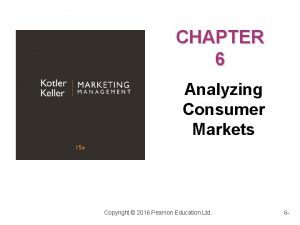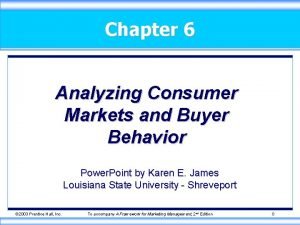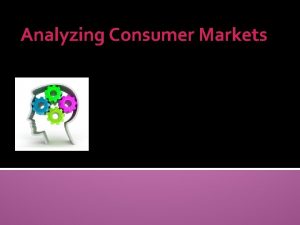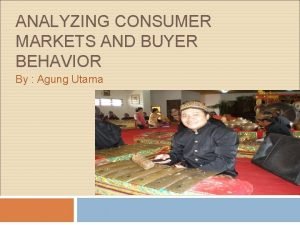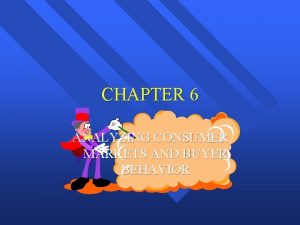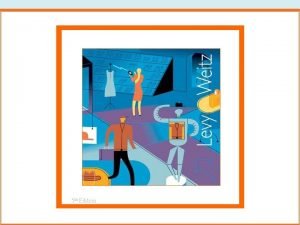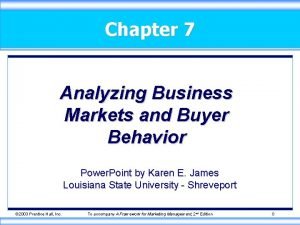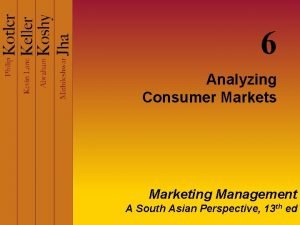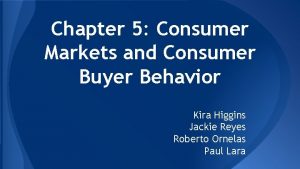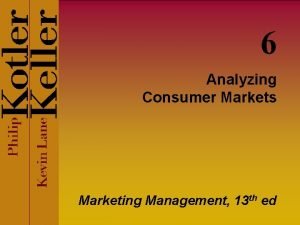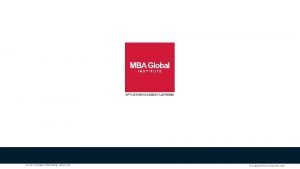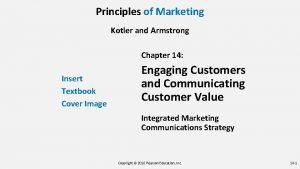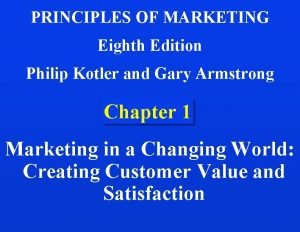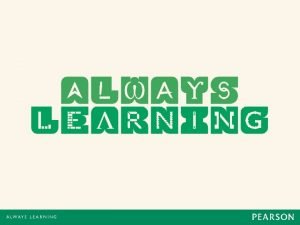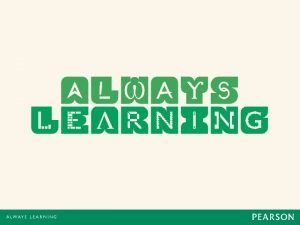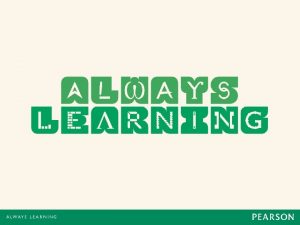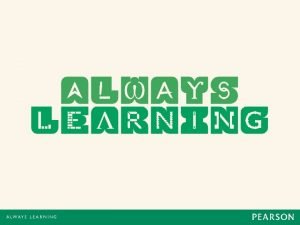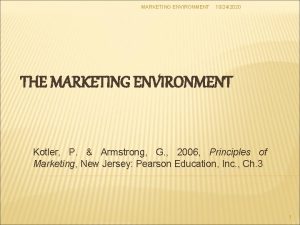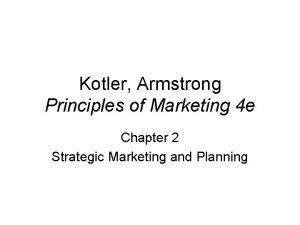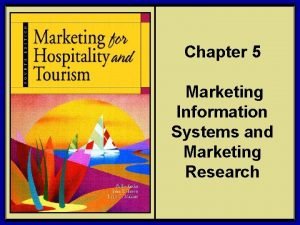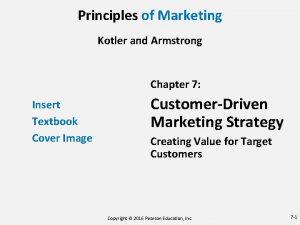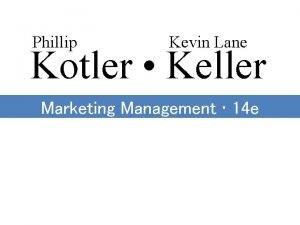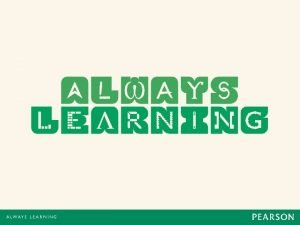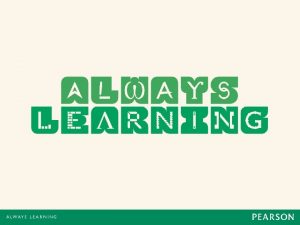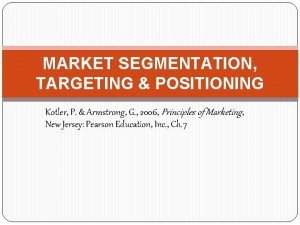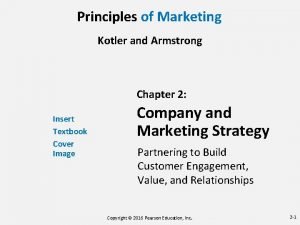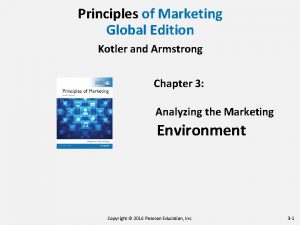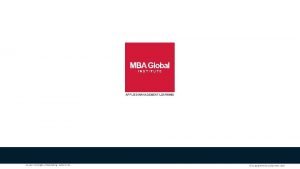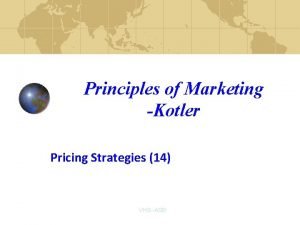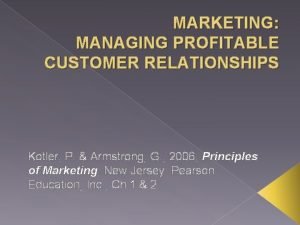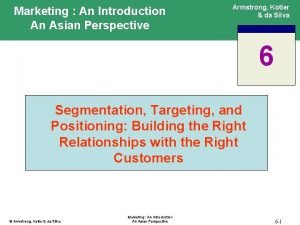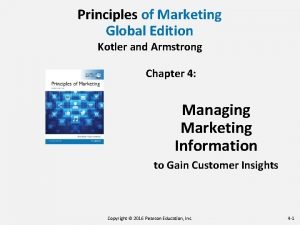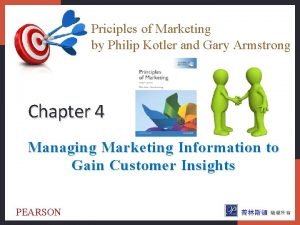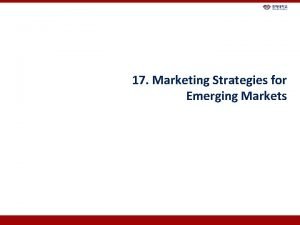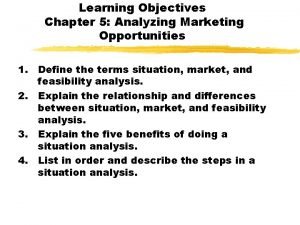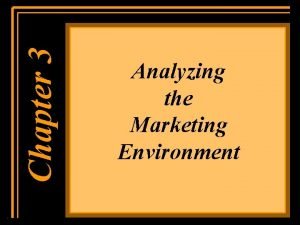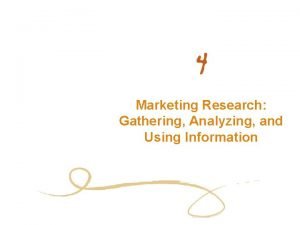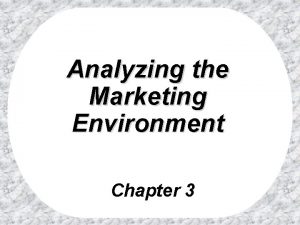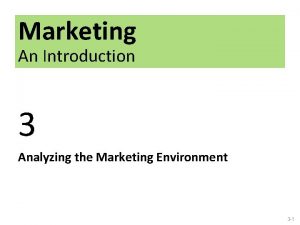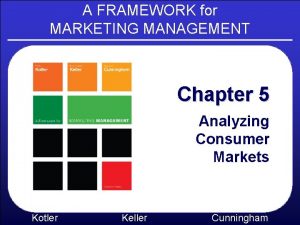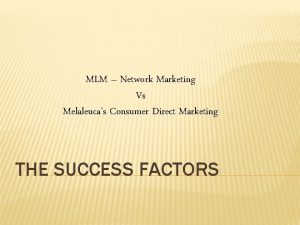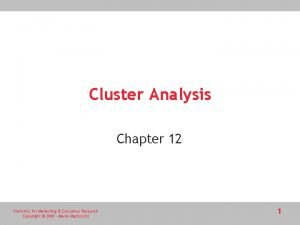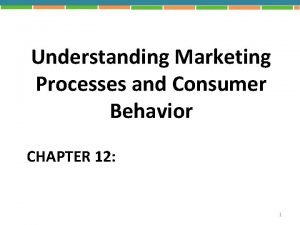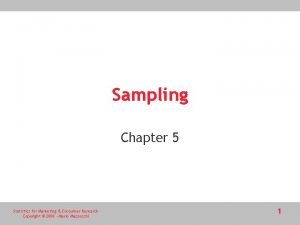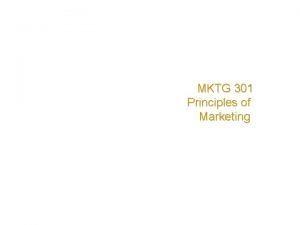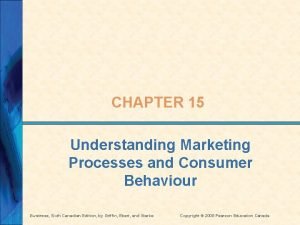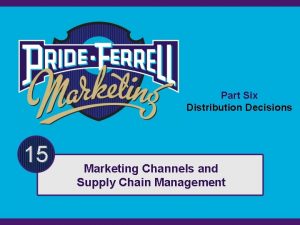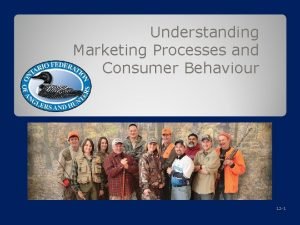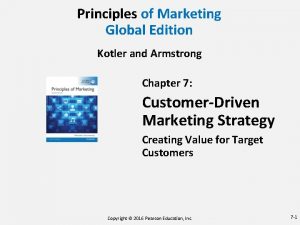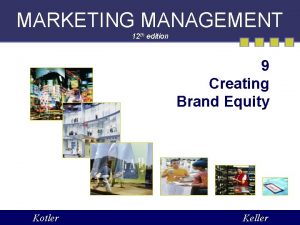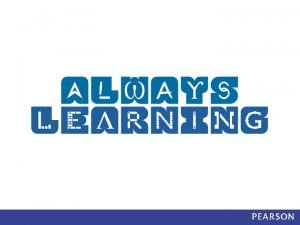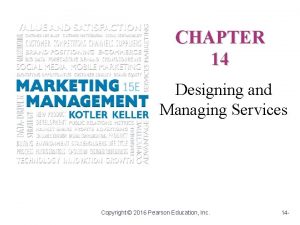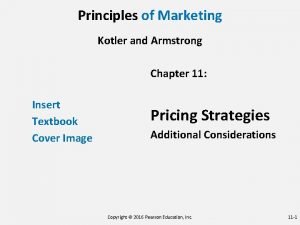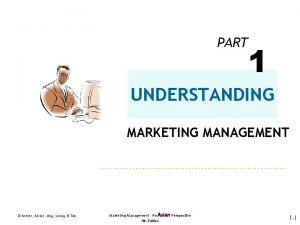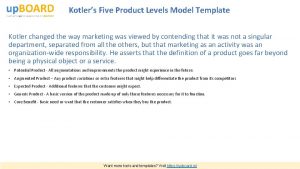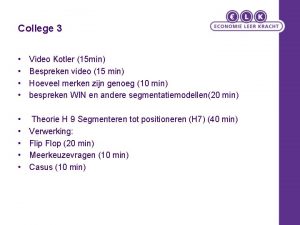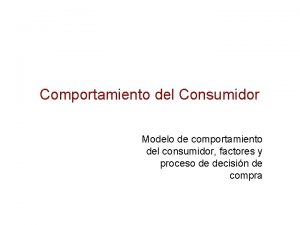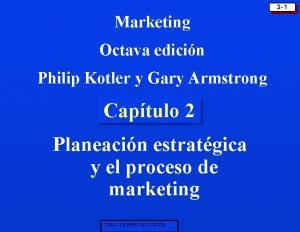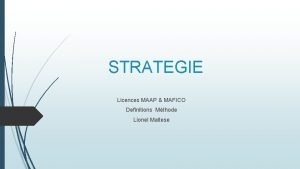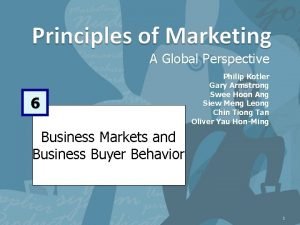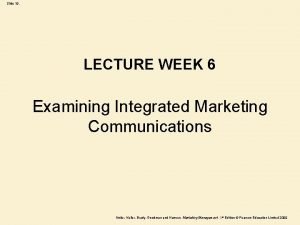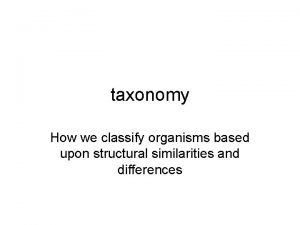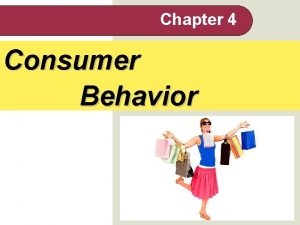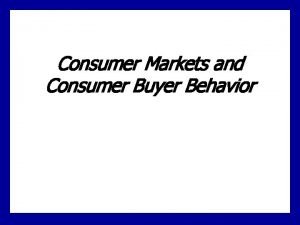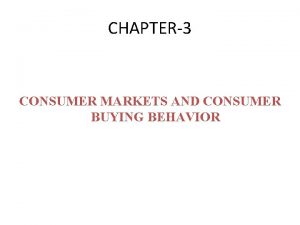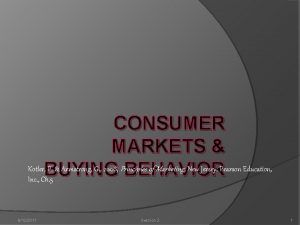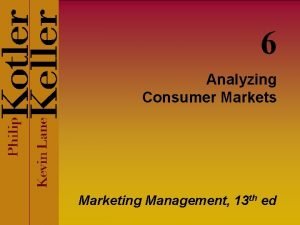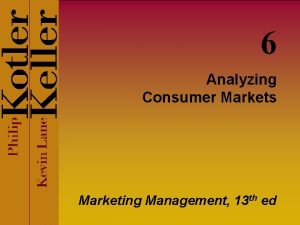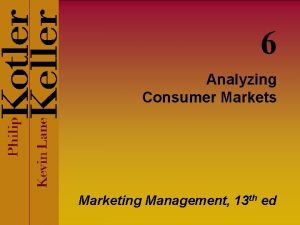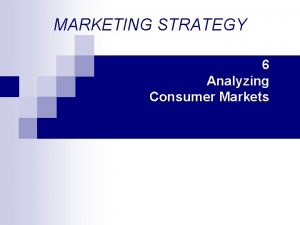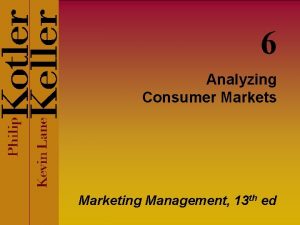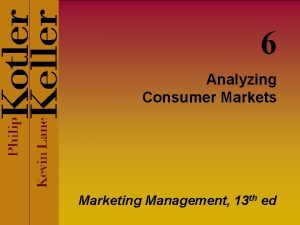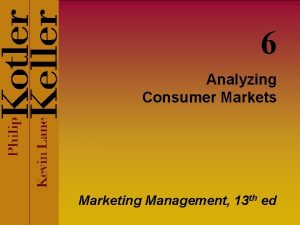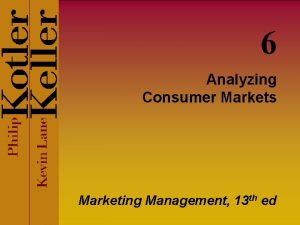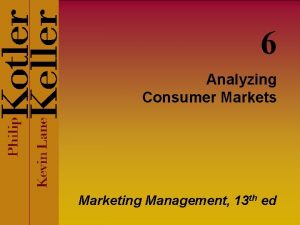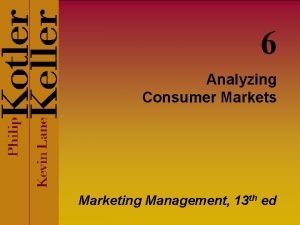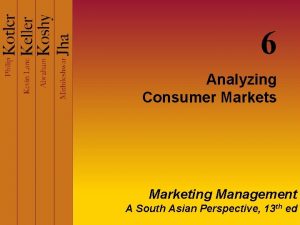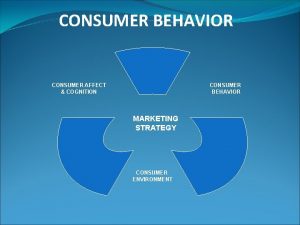Analyzing Consumer Markets Kotler on Marketing The most

































































































































- Slides: 129

Analyzing Consumer Markets

Kotler on Marketing The most important thing is to forecast where customers are moving, and be in front of them.

Chapter Questions How do consumer characteristics influence buying behavior? What major psychological processes influence consumer responses to the marketing program? How do consumers make purchasing decisions? How do marketers analyze consumer decision making?

Model of consumer behavior Consumers make many buying decisions everyday and buying decision is the focal point of the marketer’s effort. Marketers can study actual consumer purchases to find out what they buy, where and how much, but learning the why’s of the consumer buying behavior is not easy- the answer is locked deep within the consumer’s mind.

Model of Consumer Behavior Buyer’s Black Box

Model of consumer behavior Many different factors affect consumer buying behavior. Buying behavior is never simple. Understanding it, however, is the essential task of marketing management.

Model of consumer behavior Consumer buyer behavior refers to the buying behavior of final consumers(individuals and households who buy goods and services for personal consumption). Consumer market refers to all of the personal consumption of final consumers

Model of consumer behavior 1)The American consumer market consists of about 287 million people. 2)These people consume trillions of dollars of goods and services each year. 3)The world consumer market consists of more than 6. 2 billion people. 4)Consumers vary tremendously in age, income, education level, and tastes.

Factors Influencing Consumer Behavior Cultural Factors Social Factors Personal Factors Psychological Factors

Factors Influencing Consumer Behavior

Cultural Factors Cultural factors exert the broadest and deepest influence on consumer behavior. The marketer needs to understand the role played by the buyer’s culture, subculture, and social class.

Cultural Factors (Culture) Culture is the set of basic values, perceptions, wants, and behaviors learned by a member of society from family and other important institutions. Culture is the most basic cause of a person’s wants and behavior.

Cultural Factors (Culture) Every group or society has a culture and cultural influences on buying behavior may vary greatly from one country to another. Marketers are always trying to spot cultural shifts in order to imagine new that might be wanted. products

Cultural Factors (Culture) Fast Facts About American Culture: The average American: Ø chews 300 sticks of gum a year Ø goes to the movies 9 times a year Ø takes 4 trips per year Ø attends a sporting event 7 times each year

Cultural Factors (Subculture) Each culture contains smaller subcultures. Subculture are groups of people within a culture with shared value systems based on common life experiences and situations.

Cultural Factors (Subculture) 1. Nationalities 2. Religions 3. Racial Groups 4. Geographic Regions

Cultural Factors (Subculture) Many of these subcultures make up important market segments and many times products are designed for them. Examples of important subculture groups include: Hispanic African American Asian American Mature consumers

Cultural Factors (Subculture) 1) Hispanic consumers: one third of the US population. Hispanic consumers tend to buy more branded, higher quality products. There are 35 million consumers in this group, they spend $425 billion on goods and services.

Cultural Factors (Subculture) 2) African American consumers: This group has a tremendous purchasing power. This group has a buying power of $527 billion and, if they were a separate nation, would rank among the top 15 in the world. They appear to be very price conscious, are motivated by quality and selection, and emphasize brand name and loyalty.

Cultural Factors (Subculture) 3) Asian American consumers: This group is the fastest-growing and most affluent U. S. demographic segment and now number more than 10 million with disposable income of $229 billion annually. Language and cultural tradition appear to be the largest barrier to effectively marketing to this group.

Cultural Factors (Subculture) Because of its rapid growth, however, this group will receive increased attention from marketers. More than 90% of the Asian American Go online regularly and are most comfortable with internet technology such as online banking

Cultural Factors (Subculture) 4) Mature consumers: very attractive market. The entire U. S baby boom generation, the largest and the wealthiest demographic cohort in the country. Mature consumers are not stuck in their ways

Cultural Factors (Social class) Social class : Is the relatively permanent and ordered division in a society whose members share similar values, interests, and behaviors. Social class is not determined by a single factor such as income but is measured as a combination of occupation, income, education, wealth, and other variables.

Cultural Factors(Social class) In some social systems, members of different classes are reared for certain roles and can’t change their social positions. In other country, however, the lines between social classes are not fixed and rigid, people can move to a higher social class or drop into a lower one.

Cultural Factors(Social class) Marketers are interested in social class because within a given social class tend to exhibit similar buying behavior. Social classes show distinct product and brand preferences in areas such as clothing , home furnishings, and automobiles.

Cultural Factors(Social class) Social scientists have identified seven American social classes: a)Uppers (less than 1 percent). b)Lower Uppers (about 2 percent). c)Upper Middles (about 12 percent). d)Middle Class (about 32 percent). e)Working Class (about 38 percent). f)Upper Lowers (about 9 percent). g)Lowers (about 7 percent).

Cultural Factors(Social class)

Social Factors Reference Groups Family Status Social Roles Consumer

Social Factors A consumer’s behavior is influenced by social factors. These include small groups, family, and social roles and status

Social Factors (Groups) A person’s behavior is influenced by many small groups. There are several specialized group formations within the larger configuration. Reference groups: 1. Membership groups ▪ Primary groups ▪ Secondary groups 2. Aspirational groups 3. Dissociative groups 4. Opinion leaders

Social Factors (Groups) Reference groups: Groups that have a direct (face-to-face) or indirect influence on the person’s attitudes or behavior. People are often influenced by reference groups to which they do not belong.

Social Factors (Groups) Membership groups: Groups that have a direct influence on a person’s behavior; they are groups to which a person belongs. Primary groups: Person interacts informally such as family , friends , neighbors. Secondary groups: Person tend to be formal and require less interaction such as religious , professional and trade union groups.

Social Factors (Groups) Reference groups influence members in at least three ways: Reference groups expose a person to new behaviors and lifestyles. Influence the person’s attitudes and self-concept. They also create pressures to conform that may affect the person’s product and brand choices.

Social Factors (Groups) People are influenced by groups to which they don’t belong: Aspirational group: A group to which an individual wishes to belong. Dissociative group: A group to which an individual reject to join because their values and behaviors.

Social Factors (Groups) Word-of-mouth influence and buzz marketing. Opinion leaders: people within a reference group who have their special skills , knowledge , personality , to exert social influence on others. Also called influentials or leading adopters Marketers identify them to use as brand ambassadors.

Social Factors (Groups) Online Social Networks are online communities where people socialize or exchange information and opinions. Include blogs, social networking sites (facebook), virtual worlds (second life).

Social Factors (Family) A consumer’s purchases are also influenced by family members. The influence can be very strong because the family is the most important consumerbuying organization in society. It has been extensively researched.

Social Factors (Family) There are two kinds of families in the buyer’s life: 1. Family of orientation: Consists of Parents & relatives. In America 40% of families have auto insurance with the same company as the husband’s parents. 2. Family of procreation: Consists of husband & wife & children.

Social Factors (Family) Marketers are interested in the roles and influence of the husband, wife and children on the purchase of different products and services. The wife traditionally has been the main purchasing agent for the family.

Social Factors (Family) Children may also have a strong influence on family buying decisions. Studies found that kids influence family decisions about where they take vacations , what cars or cell phones they buy. As a result , marketers of cars , full service restaurants , cell phones are now placing ads on the children oriented TV networks.

Social Factors (roles and status) Social roles and status are the groups, family, clubs, and organizations that a person belongs to that can define role and social status. A role consists of the activities that people expected to perform according to the persons around them.

Social Factors (roles and status) Each role carries a status reflecting the general esteem given to it by society. People usually choose products appropriate to their roles and status.

Personal Factors A buyer’s decisions are also influenced by personal characteristics such the buyer’s age and life-cycle stage, occupation, economic situation, lifestyle, personality and self-concept.

Personal Factors Age Selfconcept Life cycle stage Lifestyle Occupation Values Wealth Personality

Personal Factors (Age and life-cycle stage) Age 21 y. What are their critical life events at their age? Life Cycle What are their current psychological life stages that matter?

Personal Factors (Age and life-cycle stage) Age and life-cycle stage People change the goods and services they buy over their lifetimes. Tastes in food, clothes, furniture and recreation are age related. Buying is also shaped by the stage of the family life cycle that is the stages through which families might pass as they mature over time.

Personal Factors (Age and life-cycle stage) Traditional family life cycle stages include young singles and married couples with children. The nontraditional stages such as unmarried couples, singles marrying later in life, single parents , extended parents ( those with young adult children returning home ) and others

Personal Factors (Age and life-cycle stage) RBC Royal Bank stages Youth: younger than 18 Getting started: 18– 35 who are going through first experiences, first credit card, first car , first child. Builders: 35– 50 in their peak earning years, as they build careers and family, they tend to borrow more than they invest.

Personal Factors (Age and life-cycle stage) • Accumulators: 50– 60 Worry about saving for retirement and invested wisely. • Preservers: over 60 Want to maximize their retirement income to maintain a desired lifestyle.

Personal Factors (Occupation) Occupation What are their consumption Patterns due to their current Occupations?

Personal Factors (Occupation) Occupation: A person’s occupation affects the goods and services bought (software bought by accountants, lawyers, and doctors). Blue workers tend to buy more rugged work clothes, whereas executives buy more business suits. A company can specialize in making products needed by a given occupational group.

Personal Factors (Wealth) Wealth How much are they willing To spend?

Personal Factors (Wealth) Economic situation includes trends in: Personal income Savings Interest rates If economic indicators point to a recession, marketers can take steps to redesign , and reprice their products closely.

Personal Factors (Wealth) The economic situation of the buyer is very important in purchase consideration. If a person fears losing their job, their purchasing habits generally change. If the person perceives that their economic situation is going to improve, they might consider making a major purchase.

Personal Factors (Lifestyle & Values) Lifestyle Values What are things that they believe in and are important to them? What would benefit them for their way of living?

Personal Factors (Lifestyle & Values) People from the same social strata can have very different lifestyles. A lifestyle : is a person’s pattern of living as expressed in his or her psychographics (such as activities, interests, and opinions). Lifestyle profiles a person’s whole pattern of acting and interacting in the world. It is more than the person’s social class or personality.

Personal Factors (Lifestyle & Values) Examples include: Activities (work, hobbies, shopping, etc. ). Interests (food, fashion, recreation, etc. ). Opinions (about themselves, social issues, business, etc. ).

Personal Factors (Lifestyle & Values) The most widely used lifestyle classification is the SRI Values and Lifestyles (VALS) typology. VALS classifies people according to their consumption tendencies by how they spend their time and money. A person could change positions over time. It is felt that a person’s lifestyle does affect their purchase behavior. Groups are further subdivided based on selforientation and resources.

Personal Factors (Lifestyle & Values) Self-orientation groups include: Principle-oriented consumers who buy based on their views of the world. Status-oriented consumers who base their purchases on the actions and opinions of others. Action-oriented buyers who are driven by their desire for activity , variety, and risk taking.

Personal Factors (Lifestyle & Values) Resources: can be either abundant or minimal depending on whether the buyer has high or low levels of income, education, health, self-confidence, energy, and other factors.

Personal Factors (Personality and self-concept) Personality What are their traits and characteristics?

Personal Factors (Personality and self-concept) Personality : refers to the unique psychological characteristics that lead to consistent and lasting responses to the consumer’s environment. Personality is described in terms of traits (such as self-confidence, dominance sociability, etc. ).

Personal Factors (Personality and self-concept) The self-concept: describes the self-image. The basic idea is that people’s possessions contribute to and reflect their identities. (how one views oneself)

Personal Factors (Personality and self-concept) Each person’s personality and self-concept will influence their buying behavior. Personality can be useful for analyzing consumer behavior for certain brand or product choices.

Personal Factors (Personality and self-concept) Characteristics Affecting Consumer Behavior Personal Factors Dominance Autonomy Defensiveness Adaptability Aggressiveness

Personal Factors (Personality and self-concept) A brand personality: is the specific mix of the human traits that may be attributed to a particular brand. One researcher identified five brand personality traits:

Personal Factors (Personality and self-concept) Brand Personality Sincerity Excitement Competence Sophistication Ruggedness

Personal Factors (Personality and selfconcept) Sincerity ( honest, wholesome, and cheerful) Excitement ( imaginative and up-to date) Competence ( reliable , intelligent and successful ) 4. Sophistication ( upper class and charming) 5. Ruggedness ( tough and outdoorsy) 1. 2. 3.

Key Psychological Factors Motivation Perception Learning Beliefs and attitudes

Influencing Buyer Behavior Ernest Dichter’s research found: Consumers resist prunes because prunes are wrinkled looking and remind people of old age. Men smoke cigars as an adult version of thumb sucking. Women prefer vegetable shortening to animal fats because the latter arouse a sense of guilt over killing animals. Women don’t trust cake mixes unless they require adding an egg, because this helps them feel they are giving “birth. ”

The consumer’s mind responds according to… 1. Perception His interpretation of information 2. Motivation His drive to act 3. Learning His change in behavior due to experience 4. Memory His retention of experience and ideas

KEY PSYCHOLOGICAL PROCESSES The starting point for understanding consumer behavior is the stimulus response The marketer’s task is to understand what happens in the consumer’s consciousness between the arrival of the outside marketing stimuli and the ultimate purchase decisions.

Motivation A person has many needs at any given time. Some needs are: Biogenic (arise from physiological states of tension such as hunger). Others are psychogenic and arise from a need for recognition, esteem, or belonging. A motive is a need that is sufficiently pressing to drive the person to act. Motivation research refers to qualitative research designed to probe consumer’s hidden , subconscious motivations.

Motivation Psychologists have developed theories of human motivation, the most popular- theories of psychologists Frued , Maslow , Herzberg’s theories.

Motivation Freud’s Theory Maslow’s Hierarchy of Needs Herzberg’s Two-Factor Theory Behavior is guided by subconscious motivations Behavior is driven by lowest, unmet need Behavior is guided by motivating and hygiene factors

Freud’s Theory Sigmund Freud assumed that the psychological forces shaping people’s behavior are largely unconscious, and that a person cannot fully understand his or her own motivations.

Freud’s Theory A technique called laddering can be used to trace a person’s motivations from the stated instrumental ones to the more terminal ones. Motivation researchers often collect “in-depth interviews” to uncover deeper motives triggered by a product. Projective techniques such as word association, sentence completion, and role-playing are used.

Maslow’s Hierarchy of Needs

Maslow’s Theory Abraham Maslow sought to explain why people are driven by particular needs at particular times.

Maslow’s answer is that human needs are arranged in a hierarchy, from the most pressing to the least pressing. In order of importance, they are: ▪ Physiological needs. ▪ Safety needs. ▪ Social needs. ▪ Esteem needs. ▪ Self-actualization needs.

Herzberg’s Two-Factor Theory

Herzberg’s Theory Frederick Herzberg developed a two-factor theory that distinguishes dissatisfiers (factors that cause dissatisfaction) from satisfiers (factors that cause satisfaction). The absence of dissatisfiers is not enough; satisfiers must be present to motivate a purchase.

Herzberg’s theory has two implications: ▪ Sellers should do their best to avoid dissatisfies. ▪ Sellers should identify the major satisfiers or motivators of purchase in the market and supply them. These satisfiers will make the major difference as to which brand the customer buys.

Perception Selective Attention Selective Retention Selective Distortion Subliminal Perception

Perception How the motivated person actually acts is influenced by his or her view or perception of the situation. Perception is the process by which an individual selects, organizes, and interprets information inputs to create a meaningful picture of the world.

Perceptual processes Selective Attention Selective Retention Subliminal Perception Selective Distortion

Selective Attention It has been estimated that a person is exposed to over 1, 500 ads or brand communi cations a day. Because a person cannot possibly attend to all of these, most stimuli will be screened out —a process called selective attention.

Selective attention means that marketers have to work hard to attract consumers’ notice. ▪ People are more likely to notice stimuli that relates to a current need.

Selective Distortion Selective distortion is the tendency to interpret information in a way that will fit our preconceptions. Consumers will often distort information to be consistent with prior brands and product beliefs.

Selective Retention People will fail to register much information to which they are exposed in memory, but will tend to retain information that supports their attitudes and beliefs. Because of selective retention, we are likely to remember good points about a product we like and forget good points about competing products.

Learning involves changes in an individual’s behavior arising from experience, and occurs through interplay of: Ø Ø Ø Drives Stimuli Cues Responses Reinforcement

A drive : a strong internal stimulus that calls for action. A drive becomes a motive when its directed towards a particular stimulus object. Cues are minor stimuli that determine when, where and how the person responds The consumer’s response to his or her interest in buying the product

Memory All information and experiences individuals encounter as they go through life can end up in their long term memory.

THE BUYING DECISION PROCESS: THE FIVESTAGE MODEL These basic psychological processes play an important role in understanding how consumers actually make their buying decisions. Marketers must understand every facet of consumer behavior.

Types of Buying Decision Behavior Complex buying behavior Dissonance-reducing buying behavior Habitual buying behavior Variety-seeking buying behavior

Complex buying behavior When consumers are highly involved in a purchase and perceive significant differences among the brands. Consumers maybe highly involved when the product is expensive, risky and purchased infrequently Marketers need to help buyers learn about product-class attributes& their relative importance. They need to differentiate their brand features, by describing them using print media with long copy

Dissonance-reducing buying behavior Occurs when consumers are highly involved with an expensive , risky purchase but see little differences among brands Consumers might experience post purchase dissonance when they notice certain disadvantages of the purchased brand or hear favorable things about brands not purchased

Habitual buying behavior Occurs under conditions of low consumer involvement and little significant brand difference Consumers appear to have low involvement with most low cost, frequently purchased products Ad repetition creates brand familiarity rather than brand conviction “ consumers don’t form strong attitudes toward a brand, they select the brand because its familiar

Types of Buying Decision Behavior Four Types of Buying Behavior

Variety-seeking buying behavior In situations characterized by low consumer involvement but significant perceived brand differences. In such cases consumers often do a lot of brand switching Brand switching occurs for the sake of variety rather than because of dissatisfaction.

Consumer Buying Process

Problem Recognition The buying process starts when the buyer recognizes a problem or need. The need can be triggered by internal or external stimuli. Marketers need to identify the circumstances that trigger a particular need so that they can develop marketing strategies that trigger consumer interest.

Information search An aroused consumer will be inclined to search for more information. We can distinguish between two types of arousal. The milder state is called heightened attention where a person simply becomes more receptive to information about a product. The second level is active information search where a person looks for reading material, going online, etc. to learn about the product.

sources to which the consumer will turn and the relative influence each will have on the subsequent purchase decision. These information sources fall into four groups: Of key interest to the marketer are the major information

Personal (family, friends). Commercial (advertising, Web sites, salespeople). Public (mass media, consumer organizations). Experiential (handling, examining, using the product).

Generally speaking the consumer receives the most information about a product from commercial sources. The most effective information often comes from personal sources or public sources that are independent authorities. The Internet has changed information search. Most consumers are hybrid consumers.

The consumer will come to know only a subset of these brands (awareness sent). Some brands will meet initial buying criteria (consideration set).

Figure 6. 5 Successive Sets Involved in Consumer Decision Making

Evaluation of Alternatives No single process is used by all consumers or by one consumer in all buying situations. The most current models see the process as cognitively orientated.

First, the consumer is trying to satisfy a need. Second, the consumer is looking for certain benefits from the product solution. Third, the consumer sees each product as a bundle of attributes with varying abilities for delivering the benefits sought to satisfy this need.

Beliefs and Attitudes Evaluations often reflect beliefs and attitudes. Through experience and learning, people acquire beliefs and attitudes. These in turn influence buying behavior.

Belief —a descriptive thought that a person holds about something. Attitude—a person’s enduring favorable or unfavorable evaluation, emotional feeling, and action tendencies toward some object or idea.

Attitudes put people into a frame of mind. Attitudes lead people to behave in a fairly consistent way toward similar objects. Attitudes can be very difficult to change.

Purchase Decisions In the evaluation stage, the consumer forms preferences among the brands in the choice set. The consumer may also form an intention to buy the most preferred brand. In executing a purchase intention, the consumer may make up to five sub decisions:

Brand. Dealer. Quantity. Timing. Payment-method.

Table 6. 4 A Consumer’s Evaluation of Brand Beliefs About Laptops

Figure 6. 6 Stages between Evaluation of Alternatives and Purchase

A consumer’s decision to modify, postpone, or avoid a purchase decision is heavily influenced by perceived risk. There are many types of risks that consumers may perceive in buying and consuming a product:

Perceived Risk Functional Physical Financial Social Psychological Time

Post-Purchase Decision The satisfaction or dissatisfaction that the consumer feels about the purchase Relationship between: Consumer’s expectations Product’s perceived performance The larger the gap between expectation and performance, the greater the consumer’s dissatisfaction Cognitive dissonance is the discomfort caused by a post-purchase conflict

Post-Purchase Decision Customer satisfaction is a key to building profitable relationships with consumers—to keeping and growing consumers and reaping their customer lifetime value

Business organizations do not only sell. They also buy vast quantities of raw materials manufactured , components, plant and equipment, supplies , and business services.

Major Influences on Industrial Buying Behavior

The business market versus the consumer market

Participants in the Business Buying Process

The Buyer Decision Process for New Products Adoption process is the mental process an individual goes through from first learning about an innovation to final regular use. Stages in the process include: Awareness Interest Evaluation Trial Adoption

The Buyer Decision Process for New Products Influence of Product Characteristics on Rate of Adoption Relative advantage Compatibility Divisibility Complexity Communicability

How Customers Use and Dispose of Products

 Analyzing consumer markets
Analyzing consumer markets Analyzing consumer markets and buyer behavior
Analyzing consumer markets and buyer behavior Analyzing consumer markets and buyer behavior
Analyzing consumer markets and buyer behavior Analyzing consumer markets
Analyzing consumer markets Analyzing consumer market
Analyzing consumer market Analyzing consumer markets and buyer behavior
Analyzing consumer markets and buyer behavior Analyzing consumer market
Analyzing consumer market Black box model consumer behaviour
Black box model consumer behaviour Analyzing consumer markets chapter 6
Analyzing consumer markets chapter 6 Retail environment ppt
Retail environment ppt Business markets and business buyer behavior ppt
Business markets and business buyer behavior ppt Analyzing consumer markets
Analyzing consumer markets Business buyer behavior refers to the
Business buyer behavior refers to the Primary consumer in food chain
Primary consumer in food chain Chapter 5 consumer markets and buyer behavior
Chapter 5 consumer markets and buyer behavior Analyzing consumer market
Analyzing consumer market Marketing information system kotler
Marketing information system kotler 14 principles of marketing
14 principles of marketing Principles of marketing philip kotler
Principles of marketing philip kotler Capturing marketing insights
Capturing marketing insights Benefits of secondary research
Benefits of secondary research Recruise meaning
Recruise meaning Marketing management (arab world edition)
Marketing management (arab world edition) Marketing management (arab world edition) philip kotler
Marketing management (arab world edition) philip kotler Marketing management (arab world edition) philip kotler
Marketing management (arab world edition) philip kotler Marketing management (arab world edition) philip kotler
Marketing management (arab world edition) philip kotler New consumer capabilities
New consumer capabilities Define marketing information management
Define marketing information management Philip kotler marketing environment
Philip kotler marketing environment Marketing planning process kotler
Marketing planning process kotler Marketing information systems and marketing research
Marketing information systems and marketing research Chapter 7 marketing
Chapter 7 marketing Definition of marketing philip kotler
Definition of marketing philip kotler Marketing management kotler 2012
Marketing management kotler 2012 Marketing management (arab world edition) philip kotler
Marketing management (arab world edition) philip kotler Marketing management (arab world edition) philip kotler
Marketing management (arab world edition) philip kotler Kotler segmentation
Kotler segmentation Company and marketing strategy chapter 2
Company and marketing strategy chapter 2 Kotler and armstrong principles of marketing
Kotler and armstrong principles of marketing Marketing kotler
Marketing kotler Kotler's pricing strategy
Kotler's pricing strategy Marketing kotler
Marketing kotler Marketing kotler
Marketing kotler Administração de marketing kotler e keller
Administração de marketing kotler e keller Marketing research process kotler
Marketing research process kotler Types of marketing research
Types of marketing research Herbivores in the sahara desert
Herbivores in the sahara desert Consumer diversity in consumer behaviour
Consumer diversity in consumer behaviour Consumer research in consumer behaviour
Consumer research in consumer behaviour Marketing strategies for emerging markets
Marketing strategies for emerging markets Analyzing marketing opportunities
Analyzing marketing opportunities Analyzing the market environment
Analyzing the market environment Analyzing and using marketing information
Analyzing and using marketing information Marketing information and customer insights
Marketing information and customer insights Analyzing the marketing environment
Analyzing the marketing environment Marketing environment introduction
Marketing environment introduction Chapter 5 analyzing the marketing environment
Chapter 5 analyzing the marketing environment Amway vs acn
Amway vs acn Marketing consumer
Marketing consumer Marketing processes and consumer behavior
Marketing processes and consumer behavior Purposive sampling
Purposive sampling Marketing discovers consumer needs by
Marketing discovers consumer needs by Marketing processes and consumer behavior
Marketing processes and consumer behavior Distribution decisions in marketing
Distribution decisions in marketing Highly dogmatic consumers
Highly dogmatic consumers Marketing processes and consumer behavior
Marketing processes and consumer behavior Hát kết hợp bộ gõ cơ thể
Hát kết hợp bộ gõ cơ thể Slidetodoc
Slidetodoc Bổ thể
Bổ thể Tỉ lệ cơ thể trẻ em
Tỉ lệ cơ thể trẻ em Chó sói
Chó sói Tư thế worm breton
Tư thế worm breton Hát lên người ơi
Hát lên người ơi Môn thể thao bắt đầu bằng chữ f
Môn thể thao bắt đầu bằng chữ f Thế nào là hệ số cao nhất
Thế nào là hệ số cao nhất Các châu lục và đại dương trên thế giới
Các châu lục và đại dương trên thế giới Công thức tiính động năng
Công thức tiính động năng Trời xanh đây là của chúng ta thể thơ
Trời xanh đây là của chúng ta thể thơ Cách giải mật thư tọa độ
Cách giải mật thư tọa độ Làm thế nào để 102-1=99
Làm thế nào để 102-1=99 Phản ứng thế ankan
Phản ứng thế ankan Các châu lục và đại dương trên thế giới
Các châu lục và đại dương trên thế giới Thơ thất ngôn tứ tuyệt đường luật
Thơ thất ngôn tứ tuyệt đường luật Quá trình desamine hóa có thể tạo ra
Quá trình desamine hóa có thể tạo ra Một số thể thơ truyền thống
Một số thể thơ truyền thống Cái miệng nó xinh thế chỉ nói điều hay thôi
Cái miệng nó xinh thế chỉ nói điều hay thôi Vẽ hình chiếu vuông góc của vật thể sau
Vẽ hình chiếu vuông góc của vật thể sau Thế nào là sự mỏi cơ
Thế nào là sự mỏi cơ đặc điểm cơ thể của người tối cổ
đặc điểm cơ thể của người tối cổ Ví dụ về giọng cùng tên
Ví dụ về giọng cùng tên Vẽ hình chiếu đứng bằng cạnh của vật thể
Vẽ hình chiếu đứng bằng cạnh của vật thể Fecboak
Fecboak Thẻ vin
Thẻ vin đại từ thay thế
đại từ thay thế điện thế nghỉ
điện thế nghỉ Tư thế ngồi viết
Tư thế ngồi viết Diễn thế sinh thái là
Diễn thế sinh thái là Dot
Dot Số nguyên tố là
Số nguyên tố là Tư thế ngồi viết
Tư thế ngồi viết Lời thề hippocrates
Lời thề hippocrates Thiếu nhi thế giới liên hoan
Thiếu nhi thế giới liên hoan ưu thế lai là gì
ưu thế lai là gì Hổ đẻ mỗi lứa mấy con
Hổ đẻ mỗi lứa mấy con Sự nuôi và dạy con của hươu
Sự nuôi và dạy con của hươu Sơ đồ cơ thể người
Sơ đồ cơ thể người Từ ngữ thể hiện lòng nhân hậu
Từ ngữ thể hiện lòng nhân hậu Thế nào là mạng điện lắp đặt kiểu nổi
Thế nào là mạng điện lắp đặt kiểu nổi The boy in the striped pajamas fury
The boy in the striped pajamas fury Positioning kotler
Positioning kotler Demand measurement in marketing
Demand measurement in marketing Creating brand equity kotler
Creating brand equity kotler Good competitors
Good competitors Services are typically produced and consumed simultaneously
Services are typically produced and consumed simultaneously Why is chapter 6 called the overpaid maid
Why is chapter 6 called the overpaid maid Marketing chapter 11
Marketing chapter 11 Keller
Keller Five product levels
Five product levels Positioneringsgrafiek
Positioneringsgrafiek Penetratiepolitiek voorbeeld
Penetratiepolitiek voorbeeld Modelo de comportamiento del consumidor kotler
Modelo de comportamiento del consumidor kotler Kotler 2002
Kotler 2002 Licence maap
Licence maap Estrategias de kotler
Estrategias de kotler Philip kotler
Philip kotler Buyer readiness stages kotler
Buyer readiness stages kotler Product life cycle kotler
Product life cycle kotler Kotler 2002
Kotler 2002 Teniente kotler
Teniente kotler Most general to most specific classification
Most general to most specific classification
